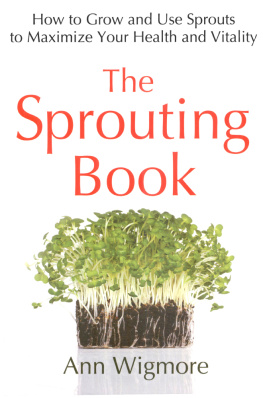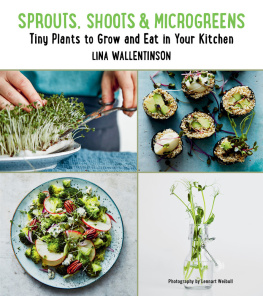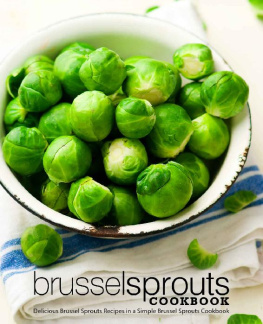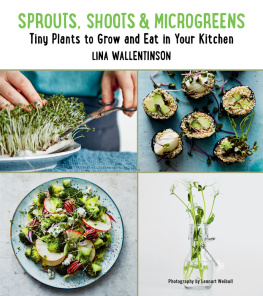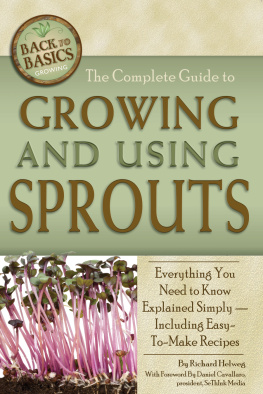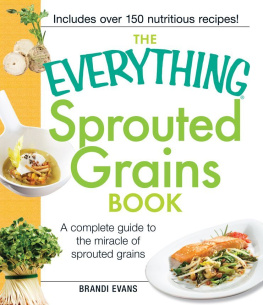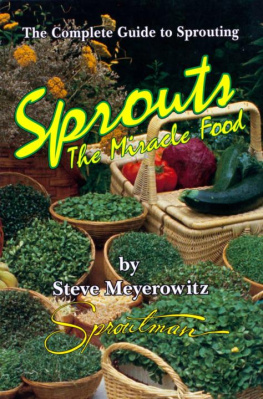The therapeutic procedures in this book are based on the training, personal experiences, and research of the author. Because each person and situation are unique, the author and publisher urge the reader to check with a qualified health professional before using any procedure where there is any question as to its appropriateness.
The publisher does not advocate the use of any particular diet and health program, but believes the information presented in this book should be available to the public.
Because there is always some risk involved, the author and publisher are not responsible for any adverse effects or consequences resulting from the use of any of the suggestions, preparations, or procedures in this book. Please do not use the book if you are unwilling to assume the risk. Feel free to consult a physician or other qualified health professional. It is a sign of wisdom, not cowardice, to seek a second or third opinion.
Library of Congress Cataloging-in-Publication Data
Wigmore, Ann, 1909
The sprouting book.
Includes index.
1. Cookery (Sprouts) 2. Sprouts. 3. Raw food diet. I. Title.
TX801.W49 1986 641.65 8610713
ISBN 978-1-101-66238-0
Copyright 1986 by Ann Wigmore
All rights reserved. No part of this publication may be reproduced, stored in a retrieval system, or transmitted, in any form or by any means, electronic, mechanical, photocopying, recording, or otherwise, without the prior written permission of the copyright owner.
Preface
Sprouts, while inexpensive and easy to grow, afford one of the most concentrated but truly natural sources of vitamins, minerals, enzymes, and amino acids (protein) known. They are also biogenicaliveand capable of transferring their life energy to your body.
Biogenic foods are foods that when planted will create new life. All raw, unsprouted seeds, beans, grains, and nuts are biogenic. When they are sprouted and eaten, they provide the body with a form of living energya composite of vital food factors not yet isolated by scientists, but proven to be of value in natures laboratory of day-to-day life.
Other important foods, such as fresh vegetables and fruits (before cooking), are considered bioactive. That is, while they are rich in organic vitamins, minerals, proteins, and living enzymes, and can contribute to improved well-being, they are not capable of creating new life.
At the other extreme are processed, denatured, and cooked foods, on which I feel modern people have become altogether too dependent. In the Living Food Lifestyle, I suggest that these foods be eaten infrequently or avoided altogether.
Some thirty-five years ago, I began my search for a food or combination of natural ingredients that could regenerate and rejuvenate my own ailing body. For years I had suffered with poor digestion, which finally resulted in colitis, a form of intestinal irritation and bleeding. In addition, arthritis was beginning to stiffen my joints and my hair was turning grey.
I found what I was looking for, and much morean edible plant food that would grow indoors in any climate and mature in a few days, rather than the 50 to 130 days required to grow fresh fruits and vegetables. An inexpensive food that would rival red meat and garden produce in nutritional value, would need no processing or preparation, and would be easy to digest, even for people with weak digestion. What I found was sprouted seeds, beans, grains, and nuts. (A fuller account of my search for healthful plant foods appears in my autobiography, Why Suffer?)
When you eat a sprout you are eating a tiny, easy-to-digest plant that is at its peak of nutritional value. The seed releases all of its stored nutrients in a burst of vitality as it attempts to become a full-sized plant. When you eat a sprout, you literally get the best of what a seed, be it radish, alfalfa, or any of the other edible varieties, has to offer in terms of nutrition.
For more than thirty-five years, I have run a series of two-week educational programs at my health center in Boston, and in lectures around the world, I have taught tens of thousands of people how to control their diet and improve health using my Living Food Diet. This natural foods diet is composed of raw, uncooked foods such as sprouts, greens, fresh vegetables and fruits, sea vegetables, and naturally fermented products. This diet has grown in popularity over the years, and has become the nucleus of a practical form of truly healthful living.
At the very center of the Living Food Diet are sprouts and indoor garden greens. In fact, up to fifty percent of the food served at the Ann Wigmore Foundation consists of fresh sprouts and greens, all grown right on the premises. I myself have lived primarily on sprouted seeds, beans, grains, and nuts for more than two decades. Not only have I healed my body of colitis and arthritis following such a regimen, but I have also achieved a greater level of vitality and health than I had even as a childand I am no child at seventy-seven. And my hair has returned to its natural brown color, too!
Sprouts are food for a new generation, and for our own re-generation as well. In The Sprouting Book, you will learn the secrets of my success growing and using sprouts to improve health.
explains how you can grow salad greens indoors as well.
illustrates two other aspects of the complete sprouting lifestyle: ways of growing sprouts while traveling or camping, and how to use sprouts to improve the health of your pets.
You dont have to be a fanatic to enjoy the flavor and health benefits of sprouts. The addition of even a cup or two of sprouts to your daily diet will make a big difference in the way you feel. Sprouting fits into almost any lifestyle. It is ideal for dieters, growing children, the elderly, vegetarians, athletes, people on the go who dont always eat right, and anyone who wants to look and feel better.
In more ways than one, sprouts are food for a new generation. Arent you ready for economic savings, renewed health and vigor, and the variety and great taste of sproutsthe unique, life-giving food?
Nutritious Living Foods
Ancient Medicine, Modern Food
Germinated and sprouted seeds are instinctive, primeval foods of man, with many millions of years of phylogenetic [evolutionary] affinity.
Edmond Szekely
The history of the various ways sprouts have been used is fascinating. Sprouts have been included in the dietand medicineof dozens of cultures from East to West. The use of sprouts is even older than the Bible. In this chapter we will discuss some of the ways sprouts were and are used by traditional peoples, and trace their recent popularity in America and the Western World.
Ancient manuscripts show us that by about 3000 B.C., the Chinese were eating bean sprouts on a regular basis. The Emperor of China at that time also recorded certain therapeutic uses of sprouts in a book about medicinal herbs. He indicated that sprouted beans could help cure such diverse problems as bloating, loss of nerve sensation, muscular cramps, digestive disorders, and weakness of the lungs.
In the late sixteenth century, Li Shih Chens Pen Tsao Kang Mu

